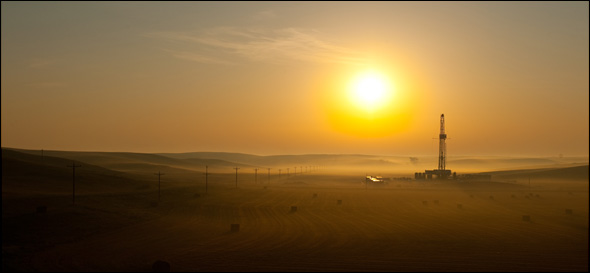First Time Key Global Energy Report Highlights Water Constraints of Energy Production
Energy is becoming a thirstier resource, the report states.

Brett Walton
Circle of Blue
By 2035, water use for energy production will rise by 20 percent and water consumption — driven by biofuel production and new power plant technologies that draw less water but evaporate more of it — will jump by 85 percent, according to the annual forecast from the International Energy Agency, a research body comprised of 28 rich-world countries.
The IEA has published its World Energy Outlook since 1994, but this is the first time that the report has included a stand-alone section on the challenges that scarce water supplies pose to energy production and electricity generation.
“The World Energy Outlook is a major resource for people looking at where the energy sector is going,” said John Rogers, the co-manager of the energy and water initiative of the Union of Concerned Scientists, a Massachusetts-based nonprofit. “I think it’s great that the IEA is providing a broader perspective on the collision between the two resources.”
Michael Webber, a national expert on the connections between water and energy and an associate professor of mechanical engineering at the University of Texas, agreed. “I think it’s a big deal that the IEA incorporated water into its analysis,” he told Circle of Blue.
Energy, according to the report, accounted for 15 percent of global water withdrawals in 2010. Of the 583 billion cubic meters withdrawn, slightly more than 11 percent, or 66 billion cubic meters, was consumed.
Rogers told Circle of Blue that the projected 85 percent increase in water consumption by the energy sector is certainly plausible, depending on how the assumptions about biofuels play out.
Any forecast has to make assumptions, and in its central scenario, the EIA assumed no fundamental changes in the global energy system. In other words, carbon emissions would continue to increase, fossil fuels remain dominant, and energy demand is pulled by rising living standards in China and India.
The report’s major findings are:
- Under its central scenario, global energy demand, driven by higher living standards for the 2.6 billion people in China and India, rises by third by 2035.
- Energy efficiency, however, can cut the growth in energy demand in half by 2035. Efficiency also brings economic benefits and reductions in carbon emissions that could delay a dangerous rise in global average temperatures, according to the report.
- Renewable energy’s share of global electricity generation rises from 20 percent in 2010 to 31 percent by 2035.
- Globally, subsidies for fossil fuels totaled $US 533 billion in 2011, compared to just $US
88 billion for renewable energy. - Thanks to the unconventional oil and gas reserves unlocked by a combination of hydraulic fracturing and horizontal drilling, the United States is forecasted to become the world’s largest oil producer within the next 8 years, briefly surpassing Saudi Arabia until U.S. production begins to fall in the mid-2020s.
- In net terms, the U.S. becomes nearly self-sufficient in total energy by 2035.
A Global Challenge
For the last three years, Circle of Blue has reported on how the rapid development of unconventional oil and gas reserves has upended traditional patterns of water use and led to a new era of resource competition within the world’s two largest economies, the United States and China.
Farmers, cities, and energy companies are drawing from the same well in places as far apart as North Dakota, where the Bakken oil boom has swiftly altered economic and civic life on the northern plains, and the deserts of Inner Mongolia, where insufficient water supplies have slowed down a coal-to-liquid fuel conversion program.
Those tensions are revealed in the IEA report, which states that “water is growing in importance as a criterion for assessing the physical, economic and environmental viability of energy projects.”
In its last few reports, the IEA made discrete references to the water constraints for the Canadian tar sands, for coal-to-liquids plants, and for shale gas, but those sentences were buried within broader sections on oil and gas development.
Though energy is undoubtedly using more water, an essential third element is needed for a complete analysis, argues Bill Ritter, the director of Colorado State University’s Center for the New Energy Economy.
“We talk about water, energy and food,” Ritter told Circle of Blue. “There could be tradeoffs for developing a fossil fuel resource that affect agriculture.”
Ritter, the governor of Colorado from 2007 to 2011, recalled a case this summer in his home state where oil companies were able to outbid farmers for water at an auction in the South Platte River basin.
Water conflict, however, is not inevitable. As the report states, many forms of renewable energy, including wind and solar photovoltaic, use little or no water, and the water demands for biofuels can be cut with efficient irrigation.
Brett writes about agriculture, energy, infrastructure, and the politics and economics of water in the United States. He also writes the Federal Water Tap, Circle of Blue’s weekly digest of U.S. government water news. He is the winner of two Society of Environmental Journalists reporting awards, one of the top honors in American environmental journalism: first place for explanatory reporting for a series on septic system pollution in the United States(2016) and third place for beat reporting in a small market (2014). He received the Sierra Club’s Distinguished Service Award in 2018. Brett lives in Seattle, where he hikes the mountains and bakes pies. Contact Brett Walton











Water is used for all types of energy production the highest being in hydropower. I need the present water use in each types of energy generation. Pl provide the details. References can be communicated to me.
yours sincerely,
PROF. P.M.NATARAJAN